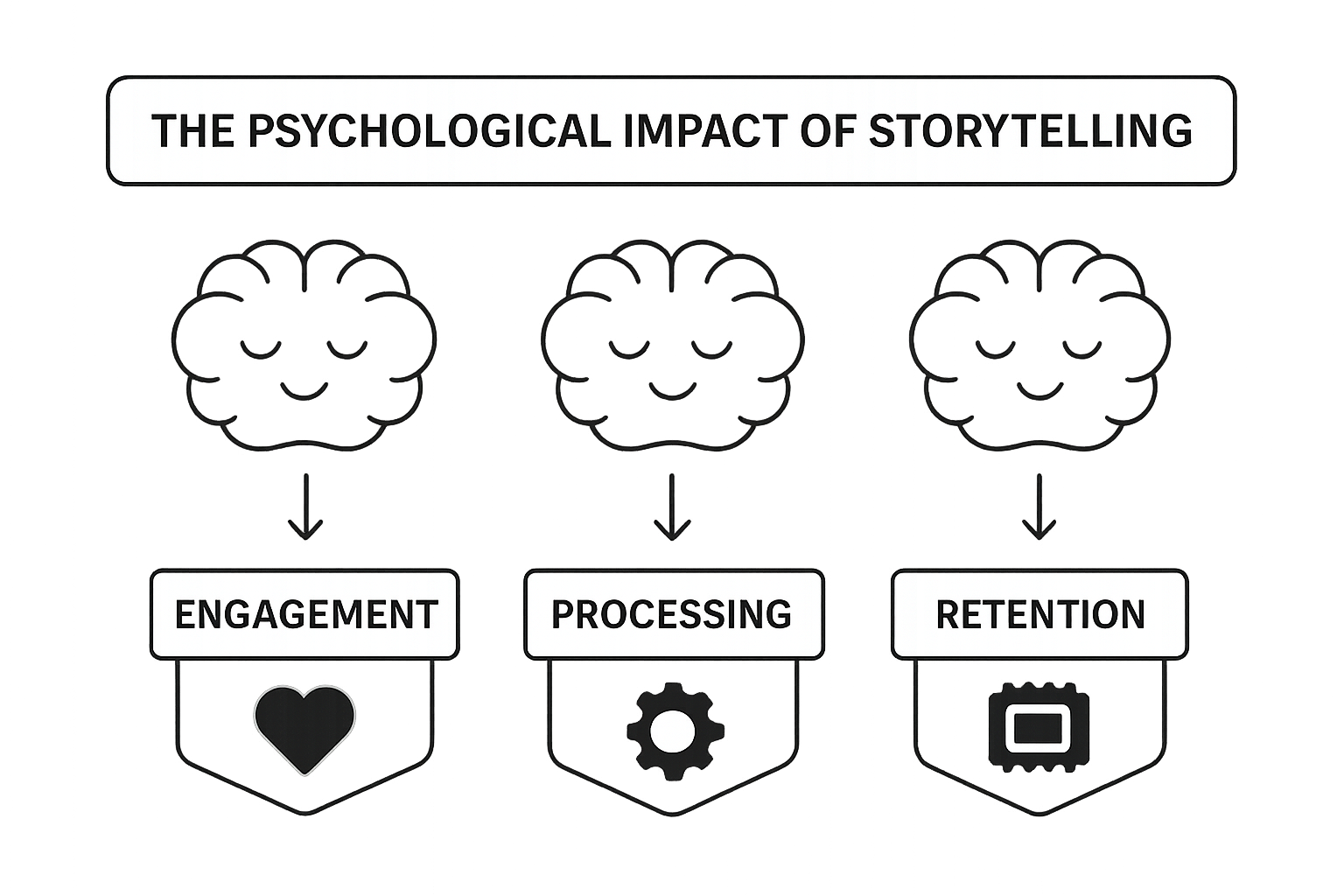Understanding Content Storytelling for Business Growth


Brands everywhere are scrambling to stand out online, but traditional ads get drowned in all the noise. Here is a wild fact. Harvard Business School found that 55 percent of consumers are more likely to buy when they love a brand’s story. Sounds simple, but most companies still treat storytelling as an afterthought. The real difference happens when brands make storytelling the center of their marketing—and transform the way people feel, remember, and act.
Table of Contents
- What Is Content Storytelling And Its Core Elements?
- Why Content Storytelling Matters For Brands And Audiences
- How Content Storytelling Engages And Retains Customers
- The Key Concepts Behind Effective Content Storytelling
- Real-World Applications And Examples Of Content Storytelling
Quick Summary
| Takeaway | Explanation |
|---|---|
| Emotional storytelling builds customer loyalty. | Narratives that evoke emotions create empathy, making customers more inclined to connect with the brand. |
| Authenticity strengthens brand narratives. | Real stories about challenges and growth resonate with audiences, enhancing trust and engagement. |
| Clear narrative structure enhances understanding. | A well-structured story guides the audience through a journey, making complex information digestible. |
| Stories create differentiation in crowded markets. | Unique narratives help brands stand out against competitors, emphasizing values and identity. |
| Align stories with customer values for impact. | When brand narratives reflect customer beliefs, it fosters a deeper connection and engagement. |
What is Content Storytelling and Its Core Elements?
Content storytelling represents a strategic communication approach where businesses transform traditional marketing messages into compelling narratives that engage, inspire, and connect with their target audience. Unlike conventional advertising, content storytelling weaves information, emotion, and purpose into a coherent narrative framework that resonates beyond simple product promotion.
Understanding the Narrative Foundation
At its core, content storytelling is about creating meaningful connections through structured, purposeful communication. Berkeley Executive Education emphasizes that effective business storytelling transcends mere fact presentation, focusing instead on communicating a clear, compelling narrative that reveals a company's deeper context.
The essential elements of content storytelling include:
- Emotional Resonance: Crafting stories that trigger genuine emotional responses
- Clear Purpose: Establishing a defined narrative objective
- Character Development: Creating relatable protagonists within the story
- Conflict and Resolution: Introducing meaningful challenges and demonstrating transformation
Constructing Powerful Business Narratives
Successful content storytelling requires understanding how to structure narratives that capture audience attention. University of Virginia's Darden School of Business highlights that impactful stories should center on transformation, clarify intent, and structure the narrative as a journey.
Businesses can achieve this by developing narratives that:
- Showcase authentic brand experiences
- Address specific audience pain points
- Demonstrate tangible solutions through storytelling
- Create memorable, shareable content experiences
The ultimate goal of content storytelling is not just information transmission but creating genuine connections that inspire trust, engagement, and long-term audience relationships. By moving beyond transactional communication, businesses can transform their content into powerful tools for building meaningful connections.
To help clarify the core elements of content storytelling, the table below outlines each element and its role in building effective business narratives.
| Element | Description |
|---|---|
| Emotional Resonance | Creates stories that trigger genuine emotional responses |
| Clear Purpose | Establishes a defined objective for the narrative |
| Character Development | Introduces relatable protagonists within the story |
| Conflict and Resolution | Presents meaningful challenges and demonstrates transformation |
| Authenticity | Ensures stories reflect real experiences and genuine brand voice |
Why Content Storytelling Matters for Brands and Audiences
Content storytelling has emerged as a critical strategy for brands seeking to differentiate themselves in an increasingly crowded digital marketplace. By transcending traditional marketing approaches, storytelling enables businesses to forge deeper, more meaningful connections with their audience through narrative techniques that engage, inform, and inspire.
The Psychological Power of Narrative
University of California, Berkeley reveals that storytelling serves as a powerful mechanism for businesses to generate trust, convey purpose, and establish meaningful connections with stakeholders. Stories organize complex information into digestible, memorable formats that resonate with human cognitive processing, making abstract concepts tangible and actionable.The psychological impact of storytelling stems from several key factors:
- Emotional Engagement: Stories trigger neural responses that create empathy and connection
- Cognitive Processing: Narratives help audiences comprehend and retain complex information
- Memory Retention: Human brains are naturally wired to remember stories more effectively than isolated facts

Strategic Benefits for Brand Communication
Brands that effectively leverage content storytelling can achieve significant competitive advantages. By moving beyond transactional communication, organizations transform their messaging from mere product descriptions to compelling narratives that reflect their values, mission, and unique identity.
The strategic benefits include:
- Building stronger audience relationships
- Differentiating from competitors through authentic storytelling
- Creating memorable brand experiences
- Enhancing audience trust and loyalty
Ultimately, content storytelling represents more than a marketing technique it is a fundamental approach to communication that recognizes the human desire for meaningful, contextual information. By crafting narratives that connect on emotional and intellectual levels, brands can create lasting impressions that drive engagement, understanding, and long-term relationship building.
How Content Storytelling Engages and Retains Customers
Content storytelling serves as a strategic approach for businesses to transform traditional customer interactions into meaningful, emotionally resonant experiences that foster long-term loyalty and engagement. By moving beyond transactional communication, brands can create narratives that speak directly to customer aspirations, challenges, and values.
The Emotional Connection Mechanism
Harvard Business School Online reveals a compelling insight: 55% of consumers are more likely to purchase a product if they love the brand's story. This statistic underscores the profound impact of narrative-driven marketing in creating deep, lasting customer relationships.Customer engagement through storytelling occurs through several critical psychological pathways:
- Emotional Resonance: Creating narratives that trigger genuine empathy
- Personal Identification: Developing stories where customers see themselves reflected
- Value Alignment: Demonstrating brand principles that match customer beliefs
Strategic Engagement Techniques
Effective content storytelling requires sophisticated strategies that go beyond simple narrative construction. Brands must craft stories that are authentic, contextually relevant, and aligned with their core identity while addressing specific customer needs and aspirations.
Key techniques for customer retention include:
- Developing multi-dimensional narratives that showcase brand evolution
- Creating content that solves customer problems
- Highlighting customer success stories and transformative experiences
- Maintaining consistent narrative themes across different communication channels
By implementing these strategies, businesses can transform content from a mere communication tool into a powerful mechanism for building trust, inspiring loyalty, and creating lasting emotional connections with their audience. Content storytelling becomes not just a marketing technique, but a fundamental approach to understanding and responding to customer desires and experiences.
The Key Concepts Behind Effective Content Storytelling
Effective content storytelling is a nuanced art that requires understanding fundamental principles that transform ordinary communication into compelling narratives. By mastering these core concepts, businesses can create stories that not only capture attention but also drive meaningful engagement and action.
Narrative Architecture
Stanford Graduate School of Business emphasizes that successful storytelling is built on a structured framework that goes beyond simple information delivery. The narrative must be carefully constructed to guide the audience through an emotional and intellectual journey that feels both authentic and purposeful.The fundamental elements of narrative architecture include:
- Clear Story Arc: Establishing a logical progression with beginning, middle, and end
- Purposeful Progression: Ensuring each narrative segment serves a strategic communication goal
- Emotional Trajectory: Creating an intentional emotional experience for the audience
Authenticity and Human Connection
At the heart of powerful storytelling lies the principle of genuine human connection. Stories must transcend mere marketing messaging to reveal the human experiences, challenges, and aspirations that resonate with the audience. This requires a deep understanding of the target audience's motivations, pain points, and emotional landscape.
Key strategies for building authentic narratives include:
- Revealing genuine brand vulnerabilities and growth stories
- Showcasing real human experiences and transformations
- Demonstrating consistent alignment between narrative and organizational values
- Creating space for audience interpretation and personal connection
By embracing these foundational concepts, businesses can develop content storytelling approaches that move beyond traditional communication strategies. The goal is not simply to inform, but to create meaningful dialogue, inspire emotional engagement, and build lasting connections that transform audiences from passive listeners to active participants in the brand's ongoing narrative.
Real-World Applications and Examples of Content Storytelling
Content storytelling transcends theoretical concepts, finding powerful expression across diverse industries and organizational contexts. By examining concrete examples, businesses can understand how narrative strategies transform communication, engagement, and brand perception.
Corporate Brand Narratives
Journal of Management Inquiry highlights how organizations leverage storytelling to create compelling brand identities. These narratives go beyond traditional marketing, revealing organizational values, challenges, and transformative journeys that resonate with stakeholders.Successful corporate storytelling approaches include:
- Origin Stories: Revealing foundational moments of company creation
- Mission-Driven Narratives: Connecting business goals with broader societal impact
- Leadership Journey Narratives: Humanizing organizational leadership
- Collaborative Transformation Stories: Showcasing team and organizational growth
Industry-Specific Storytelling Strategies
Different sectors demonstrate unique approaches to content storytelling, adapting narrative techniques to their specific audience and communication objectives. These strategies reveal how storytelling can be customized to achieve targeted engagement and communication goals.

Notable industry storytelling techniques include:
- Technology Sector: Highlighting innovation and problem-solving journeys
- Non-Profit Organizations: Demonstrating direct social impact through personal stories
- Healthcare: Sharing patient transformation and medical breakthrough narratives
- Sustainability Brands: Communicating environmental and social responsibility
By understanding these real-world applications, businesses can recognize content storytelling as more than a marketing technique. It represents a sophisticated communication strategy that bridges organizational experiences with audience expectations, creating meaningful connections that transcend traditional transactional interactions.
The following table provides a concise comparison of content storytelling techniques across different industries, demonstrating how each sector adapts narrative strategies for maximum impact.
| Industry | Primary Storytelling Focus | Example Narrative Approach |
|---|---|---|
| Technology | Innovation and problem-solving journeys | Highlighting product development stories |
| Non-Profit | Social impact and personal stories | Sharing beneficiary or donor experiences |
| Healthcare | Patient transformation and breakthroughs | Documenting medical journeys or testimonials |
| Sustainability | Environmental and social responsibility | Narratives on eco-friendly initiatives |
Ready to Transform Storytelling Into Measurable Business Growth?
The article showed how brands struggle to move beyond dry facts and generic messages that fail to connect with audiences. If you want to build emotional stories, inspire loyalty, and see real business results, the challenge is often finding the right structure and scalable approach. Many business owners wish for high-quality content that resonates and drives organic growth, but lack the time or resources to produce effective narratives consistently.

You can bridge this gap today. At Babylovegrowth.ai, we turn narrative strategies into real-world SEO wins. Our platform uses AI-driven storytelling and a proven backlink ecosystem to help your business stand out in searches and catch your audience with content that matters. Try our personalized, automated content plan now, and see how your next story can drive both connection and growth. Visit our platform to start your free trial and see storytelling and SEO work together for your brand.
Frequently Asked Questions
What is content storytelling?
Content storytelling is a strategic approach where businesses transform marketing messages into compelling narratives that engage and connect with their target audience, focusing on emotional resonance, purpose, and character development.
Why is content storytelling important for brands?
Content storytelling helps brands differentiate themselves in a crowded marketplace by creating deeper connections with their audience. It enables brands to communicate their values and mission in a compelling way that fosters trust and loyalty.
How can businesses use content storytelling to engage customers?
Businesses can engage customers through storytelling by creating narratives that address audience pain points, showcase brand authenticity, and reflect customer values. This emotional connection can significantly enhance customer loyalty.
What are key elements of effective content storytelling?
Effective content storytelling includes emotional resonance, clear purpose, character development, and conflict resolution. These elements create a cohesive narrative that engages the audience and drives meaningful interactions.
Recommended
Smart SEO,
Faster Growth!
Most Read Articles

Generative Engine Optimization (GEO)
Learn how Generative Engine Optimization (GEO) helps your content rank in AI search engines like ChatGPT and Google AI. This comprehensive guide explains the differences between SEO and GEO, why it matters for your business, and practical steps to implement GEO strategies for better visibility in AI-generated responses.

Track LLM Traffic in Google Analytics 4 (GA4)
Learn how to track and analyze traffic from AI sources like ChatGPT, Claude, Perplexity, and Google Gemini in Google Analytics 4. This step-by-step guide shows you how to set up custom filters to monitor AI-driven traffic and make data-driven decisions for your content strategy.

How to Humanize AI Text with Instructions
Learn practical techniques to make AI-generated content sound more natural and human. This guide covers active voice, direct addressing, concise writing, and other proven strategies to transform robotic text into engaging content.

Open AI Revenue and Statistics (2024)
Comprehensive analysis of OpenAI financial performance, user engagement, and market position in 2023. Discover key statistics including $20B valuation, $1B projected revenue, and 100M+ monthly active users.